Convergence, Culture, & Marginalization in Digital Media Era
VerifiedAdded on 2023/06/11
|9
|2291
|57
Essay
AI Summary
This essay examines the evolving landscape of digital media, focusing on the convergence of media forms, cultural shifts, and the marginalization of certain groups. It highlights how digital media, with its dynamic connectedness and mobile accessibility, has surpassed traditional media in popularity. The essay explores the convergence of media, the changing relationship between producers and consumers, and the use of tools like behavioral targeting. It also discusses how digital media has contributed to a global consumer culture, enabled modularity and consistency in media streaming, and revolutionized cost structures. The analysis extends to the impact of social media, transcoding, and the integration of gaming and sports. The essay concludes that while digital media offers numerous advantages, it also risks marginalizing those without access or resources, emphasizing the need to address this digital divide.
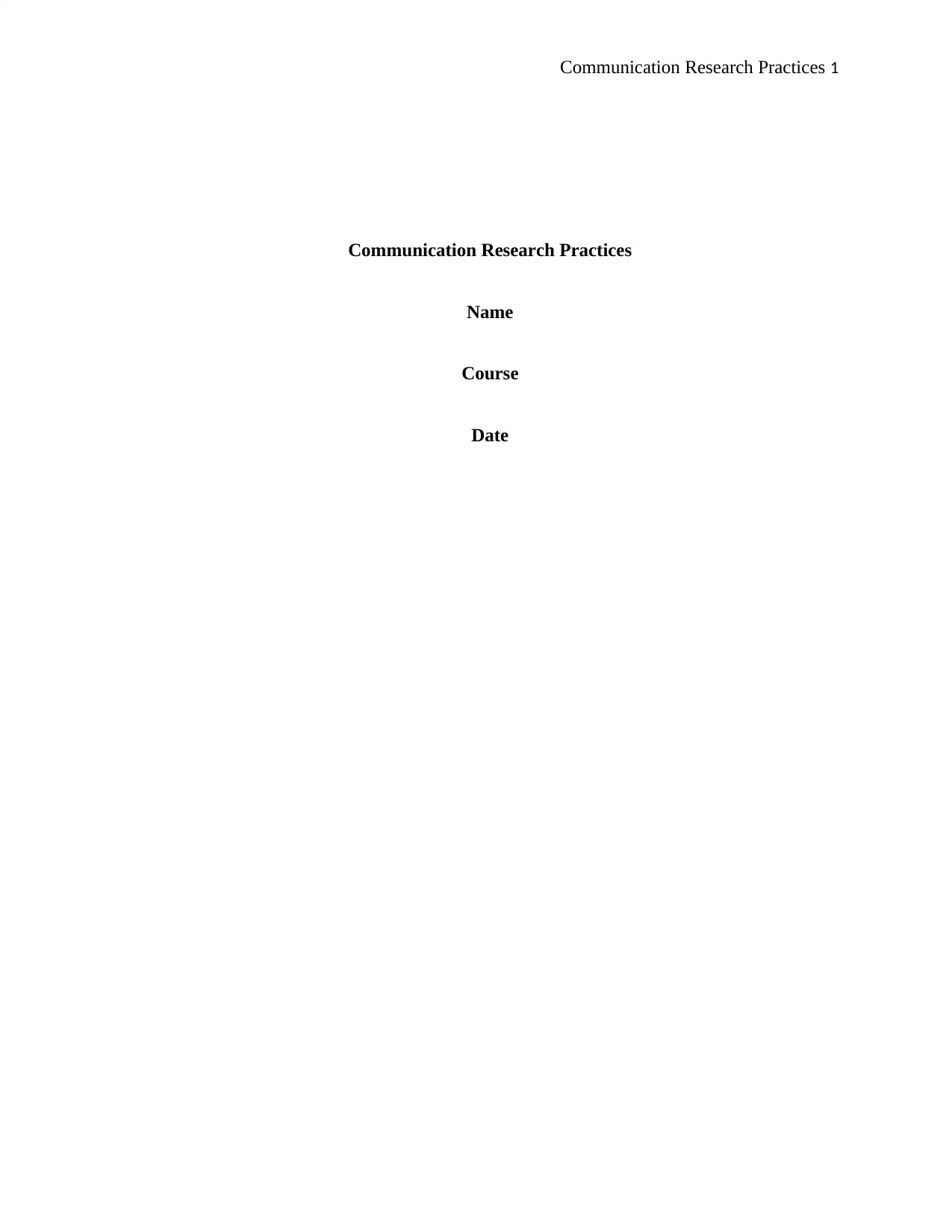
Communication Research Practices 1
Communication Research Practices
Name
Course
Date
Communication Research Practices
Name
Course
Date
Paraphrase This Document
Need a fresh take? Get an instant paraphrase of this document with our AI Paraphraser
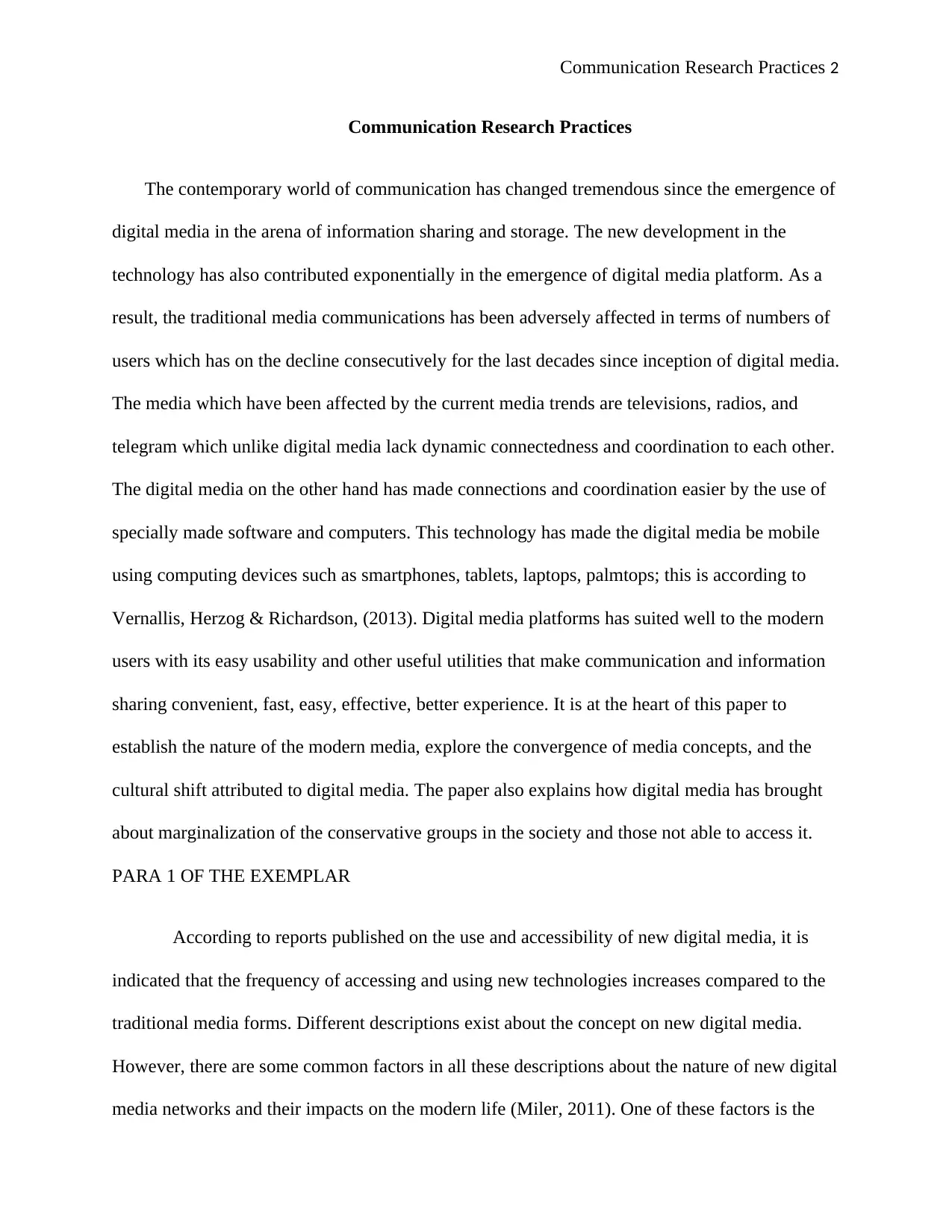
Communication Research Practices 2
Communication Research Practices
The contemporary world of communication has changed tremendous since the emergence of
digital media in the arena of information sharing and storage. The new development in the
technology has also contributed exponentially in the emergence of digital media platform. As a
result, the traditional media communications has been adversely affected in terms of numbers of
users which has on the decline consecutively for the last decades since inception of digital media.
The media which have been affected by the current media trends are televisions, radios, and
telegram which unlike digital media lack dynamic connectedness and coordination to each other.
The digital media on the other hand has made connections and coordination easier by the use of
specially made software and computers. This technology has made the digital media be mobile
using computing devices such as smartphones, tablets, laptops, palmtops; this is according to
Vernallis, Herzog & Richardson, (2013). Digital media platforms has suited well to the modern
users with its easy usability and other useful utilities that make communication and information
sharing convenient, fast, easy, effective, better experience. It is at the heart of this paper to
establish the nature of the modern media, explore the convergence of media concepts, and the
cultural shift attributed to digital media. The paper also explains how digital media has brought
about marginalization of the conservative groups in the society and those not able to access it.
PARA 1 OF THE EXEMPLAR
According to reports published on the use and accessibility of new digital media, it is
indicated that the frequency of accessing and using new technologies increases compared to the
traditional media forms. Different descriptions exist about the concept on new digital media.
However, there are some common factors in all these descriptions about the nature of new digital
media networks and their impacts on the modern life (Miler, 2011). One of these factors is the
Communication Research Practices
The contemporary world of communication has changed tremendous since the emergence of
digital media in the arena of information sharing and storage. The new development in the
technology has also contributed exponentially in the emergence of digital media platform. As a
result, the traditional media communications has been adversely affected in terms of numbers of
users which has on the decline consecutively for the last decades since inception of digital media.
The media which have been affected by the current media trends are televisions, radios, and
telegram which unlike digital media lack dynamic connectedness and coordination to each other.
The digital media on the other hand has made connections and coordination easier by the use of
specially made software and computers. This technology has made the digital media be mobile
using computing devices such as smartphones, tablets, laptops, palmtops; this is according to
Vernallis, Herzog & Richardson, (2013). Digital media platforms has suited well to the modern
users with its easy usability and other useful utilities that make communication and information
sharing convenient, fast, easy, effective, better experience. It is at the heart of this paper to
establish the nature of the modern media, explore the convergence of media concepts, and the
cultural shift attributed to digital media. The paper also explains how digital media has brought
about marginalization of the conservative groups in the society and those not able to access it.
PARA 1 OF THE EXEMPLAR
According to reports published on the use and accessibility of new digital media, it is
indicated that the frequency of accessing and using new technologies increases compared to the
traditional media forms. Different descriptions exist about the concept on new digital media.
However, there are some common factors in all these descriptions about the nature of new digital
media networks and their impacts on the modern life (Miler, 2011). One of these factors is the
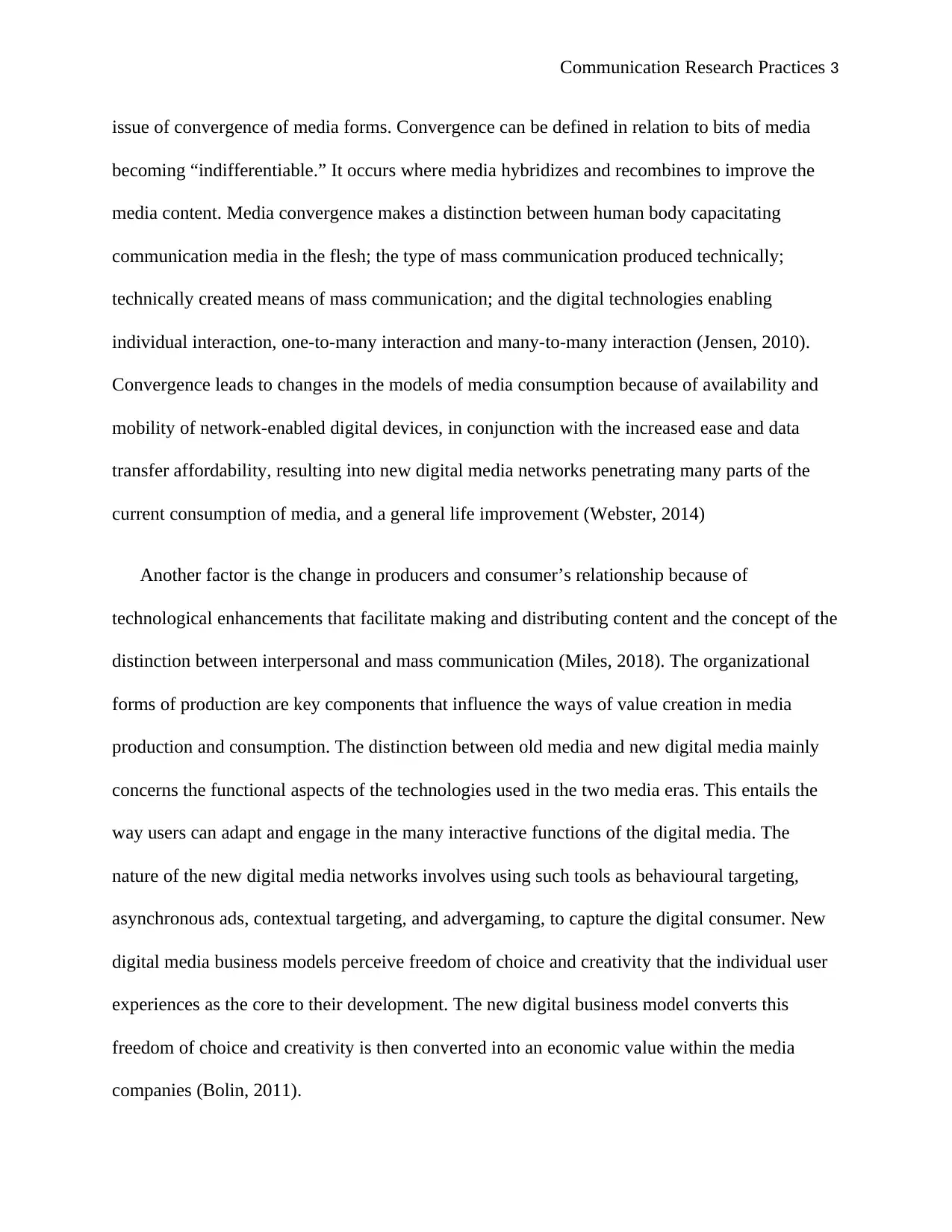
Communication Research Practices 3
issue of convergence of media forms. Convergence can be defined in relation to bits of media
becoming “indifferentiable.” It occurs where media hybridizes and recombines to improve the
media content. Media convergence makes a distinction between human body capacitating
communication media in the flesh; the type of mass communication produced technically;
technically created means of mass communication; and the digital technologies enabling
individual interaction, one-to-many interaction and many-to-many interaction (Jensen, 2010).
Convergence leads to changes in the models of media consumption because of availability and
mobility of network-enabled digital devices, in conjunction with the increased ease and data
transfer affordability, resulting into new digital media networks penetrating many parts of the
current consumption of media, and a general life improvement (Webster, 2014)
Another factor is the change in producers and consumer’s relationship because of
technological enhancements that facilitate making and distributing content and the concept of the
distinction between interpersonal and mass communication (Miles, 2018). The organizational
forms of production are key components that influence the ways of value creation in media
production and consumption. The distinction between old media and new digital media mainly
concerns the functional aspects of the technologies used in the two media eras. This entails the
way users can adapt and engage in the many interactive functions of the digital media. The
nature of the new digital media networks involves using such tools as behavioural targeting,
asynchronous ads, contextual targeting, and advergaming, to capture the digital consumer. New
digital media business models perceive freedom of choice and creativity that the individual user
experiences as the core to their development. The new digital business model converts this
freedom of choice and creativity is then converted into an economic value within the media
companies (Bolin, 2011).
issue of convergence of media forms. Convergence can be defined in relation to bits of media
becoming “indifferentiable.” It occurs where media hybridizes and recombines to improve the
media content. Media convergence makes a distinction between human body capacitating
communication media in the flesh; the type of mass communication produced technically;
technically created means of mass communication; and the digital technologies enabling
individual interaction, one-to-many interaction and many-to-many interaction (Jensen, 2010).
Convergence leads to changes in the models of media consumption because of availability and
mobility of network-enabled digital devices, in conjunction with the increased ease and data
transfer affordability, resulting into new digital media networks penetrating many parts of the
current consumption of media, and a general life improvement (Webster, 2014)
Another factor is the change in producers and consumer’s relationship because of
technological enhancements that facilitate making and distributing content and the concept of the
distinction between interpersonal and mass communication (Miles, 2018). The organizational
forms of production are key components that influence the ways of value creation in media
production and consumption. The distinction between old media and new digital media mainly
concerns the functional aspects of the technologies used in the two media eras. This entails the
way users can adapt and engage in the many interactive functions of the digital media. The
nature of the new digital media networks involves using such tools as behavioural targeting,
asynchronous ads, contextual targeting, and advergaming, to capture the digital consumer. New
digital media business models perceive freedom of choice and creativity that the individual user
experiences as the core to their development. The new digital business model converts this
freedom of choice and creativity is then converted into an economic value within the media
companies (Bolin, 2011).
⊘ This is a preview!⊘
Do you want full access?
Subscribe today to unlock all pages.

Trusted by 1+ million students worldwide
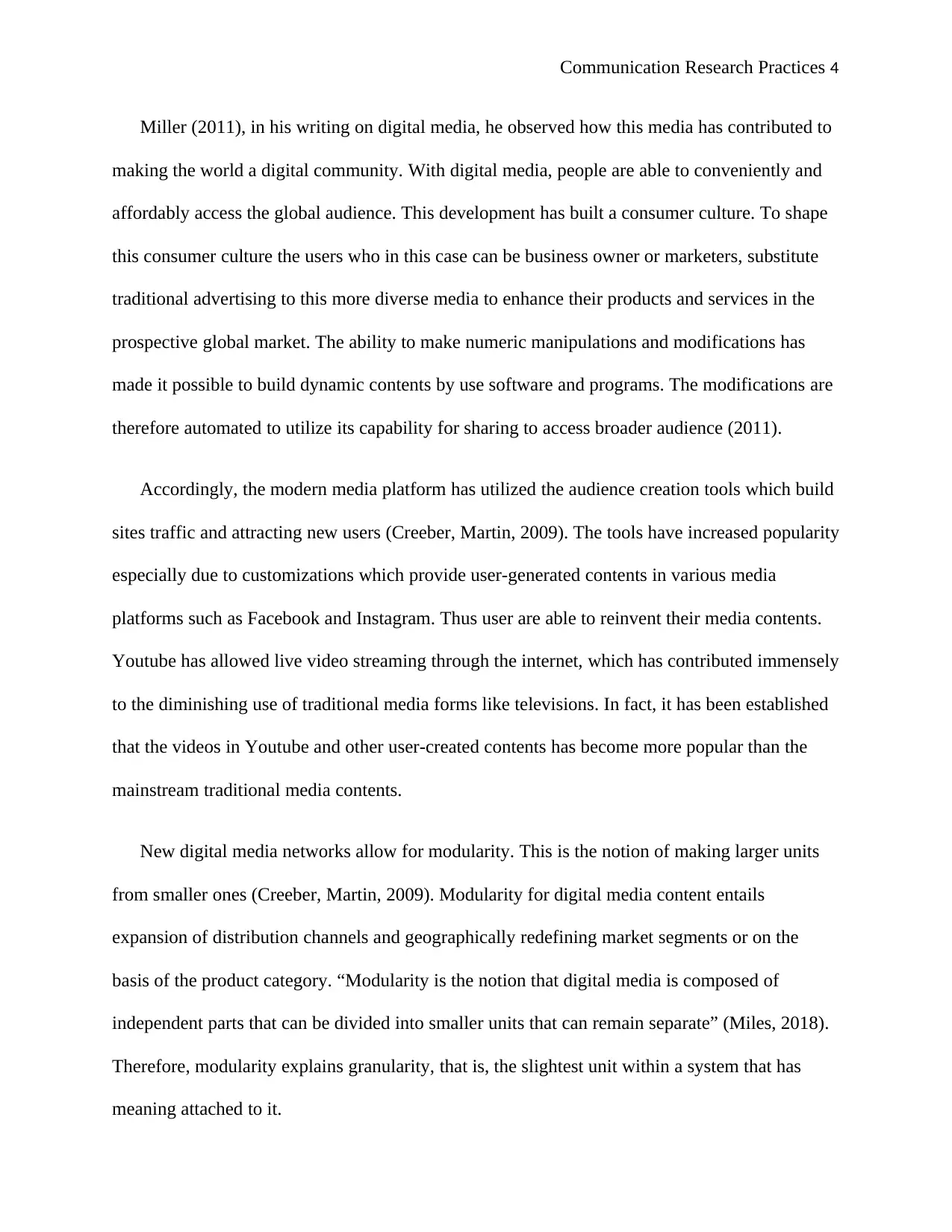
Communication Research Practices 4
Miller (2011), in his writing on digital media, he observed how this media has contributed to
making the world a digital community. With digital media, people are able to conveniently and
affordably access the global audience. This development has built a consumer culture. To shape
this consumer culture the users who in this case can be business owner or marketers, substitute
traditional advertising to this more diverse media to enhance their products and services in the
prospective global market. The ability to make numeric manipulations and modifications has
made it possible to build dynamic contents by use software and programs. The modifications are
therefore automated to utilize its capability for sharing to access broader audience (2011).
Accordingly, the modern media platform has utilized the audience creation tools which build
sites traffic and attracting new users (Creeber, Martin, 2009). The tools have increased popularity
especially due to customizations which provide user-generated contents in various media
platforms such as Facebook and Instagram. Thus user are able to reinvent their media contents.
Youtube has allowed live video streaming through the internet, which has contributed immensely
to the diminishing use of traditional media forms like televisions. In fact, it has been established
that the videos in Youtube and other user-created contents has become more popular than the
mainstream traditional media contents.
New digital media networks allow for modularity. This is the notion of making larger units
from smaller ones (Creeber, Martin, 2009). Modularity for digital media content entails
expansion of distribution channels and geographically redefining market segments or on the
basis of the product category. “Modularity is the notion that digital media is composed of
independent parts that can be divided into smaller units that can remain separate” (Miles, 2018).
Therefore, modularity explains granularity, that is, the slightest unit within a system that has
meaning attached to it.
Miller (2011), in his writing on digital media, he observed how this media has contributed to
making the world a digital community. With digital media, people are able to conveniently and
affordably access the global audience. This development has built a consumer culture. To shape
this consumer culture the users who in this case can be business owner or marketers, substitute
traditional advertising to this more diverse media to enhance their products and services in the
prospective global market. The ability to make numeric manipulations and modifications has
made it possible to build dynamic contents by use software and programs. The modifications are
therefore automated to utilize its capability for sharing to access broader audience (2011).
Accordingly, the modern media platform has utilized the audience creation tools which build
sites traffic and attracting new users (Creeber, Martin, 2009). The tools have increased popularity
especially due to customizations which provide user-generated contents in various media
platforms such as Facebook and Instagram. Thus user are able to reinvent their media contents.
Youtube has allowed live video streaming through the internet, which has contributed immensely
to the diminishing use of traditional media forms like televisions. In fact, it has been established
that the videos in Youtube and other user-created contents has become more popular than the
mainstream traditional media contents.
New digital media networks allow for modularity. This is the notion of making larger units
from smaller ones (Creeber, Martin, 2009). Modularity for digital media content entails
expansion of distribution channels and geographically redefining market segments or on the
basis of the product category. “Modularity is the notion that digital media is composed of
independent parts that can be divided into smaller units that can remain separate” (Miles, 2018).
Therefore, modularity explains granularity, that is, the slightest unit within a system that has
meaning attached to it.
Paraphrase This Document
Need a fresh take? Get an instant paraphrase of this document with our AI Paraphraser
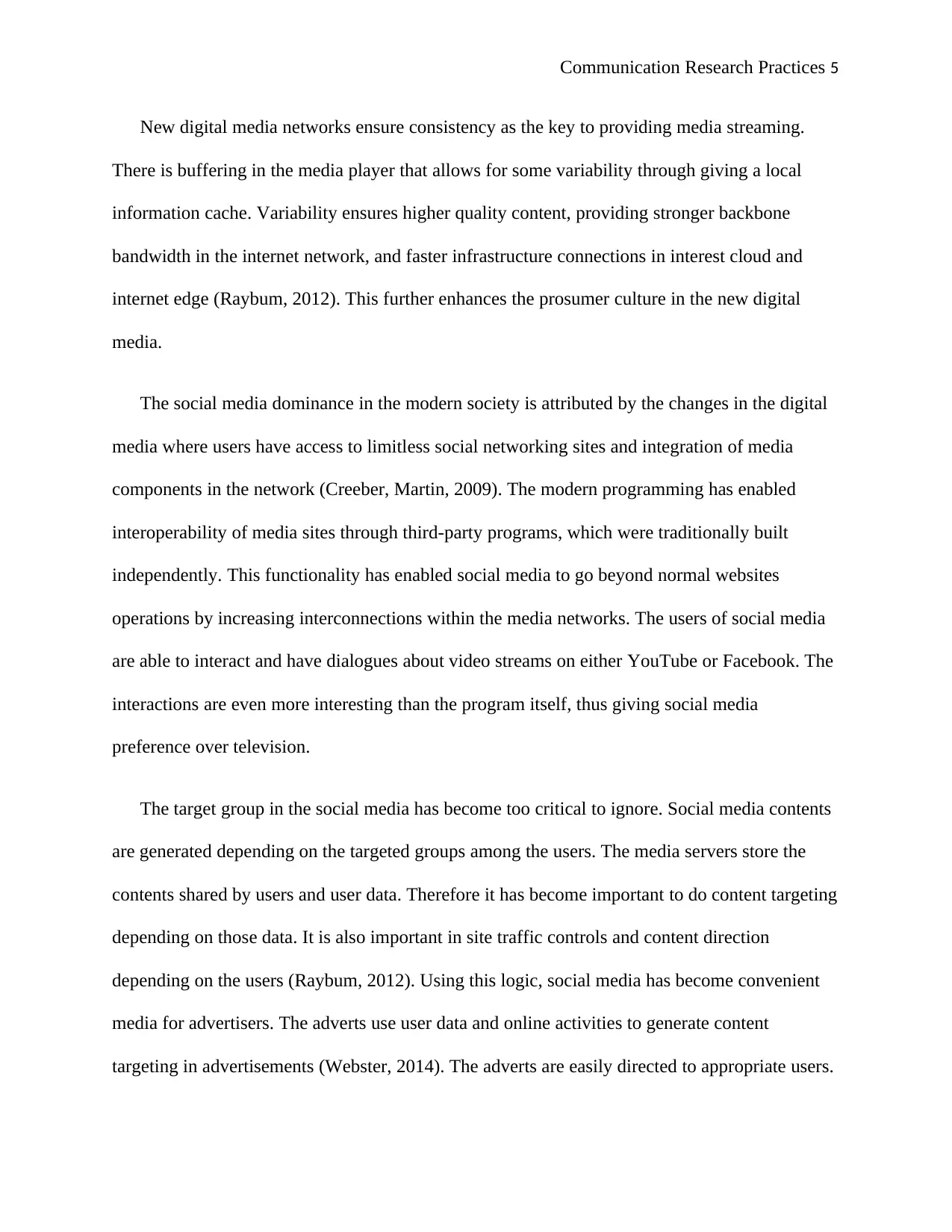
Communication Research Practices 5
New digital media networks ensure consistency as the key to providing media streaming.
There is buffering in the media player that allows for some variability through giving a local
information cache. Variability ensures higher quality content, providing stronger backbone
bandwidth in the internet network, and faster infrastructure connections in interest cloud and
internet edge (Raybum, 2012). This further enhances the prosumer culture in the new digital
media.
The social media dominance in the modern society is attributed by the changes in the digital
media where users have access to limitless social networking sites and integration of media
components in the network (Creeber, Martin, 2009). The modern programming has enabled
interoperability of media sites through third-party programs, which were traditionally built
independently. This functionality has enabled social media to go beyond normal websites
operations by increasing interconnections within the media networks. The users of social media
are able to interact and have dialogues about video streams on either YouTube or Facebook. The
interactions are even more interesting than the program itself, thus giving social media
preference over television.
The target group in the social media has become too critical to ignore. Social media contents
are generated depending on the targeted groups among the users. The media servers store the
contents shared by users and user data. Therefore it has become important to do content targeting
depending on those data. It is also important in site traffic controls and content direction
depending on the users (Raybum, 2012). Using this logic, social media has become convenient
media for advertisers. The adverts use user data and online activities to generate content
targeting in advertisements (Webster, 2014). The adverts are easily directed to appropriate users.
New digital media networks ensure consistency as the key to providing media streaming.
There is buffering in the media player that allows for some variability through giving a local
information cache. Variability ensures higher quality content, providing stronger backbone
bandwidth in the internet network, and faster infrastructure connections in interest cloud and
internet edge (Raybum, 2012). This further enhances the prosumer culture in the new digital
media.
The social media dominance in the modern society is attributed by the changes in the digital
media where users have access to limitless social networking sites and integration of media
components in the network (Creeber, Martin, 2009). The modern programming has enabled
interoperability of media sites through third-party programs, which were traditionally built
independently. This functionality has enabled social media to go beyond normal websites
operations by increasing interconnections within the media networks. The users of social media
are able to interact and have dialogues about video streams on either YouTube or Facebook. The
interactions are even more interesting than the program itself, thus giving social media
preference over television.
The target group in the social media has become too critical to ignore. Social media contents
are generated depending on the targeted groups among the users. The media servers store the
contents shared by users and user data. Therefore it has become important to do content targeting
depending on those data. It is also important in site traffic controls and content direction
depending on the users (Raybum, 2012). Using this logic, social media has become convenient
media for advertisers. The adverts use user data and online activities to generate content
targeting in advertisements (Webster, 2014). The adverts are easily directed to appropriate users.
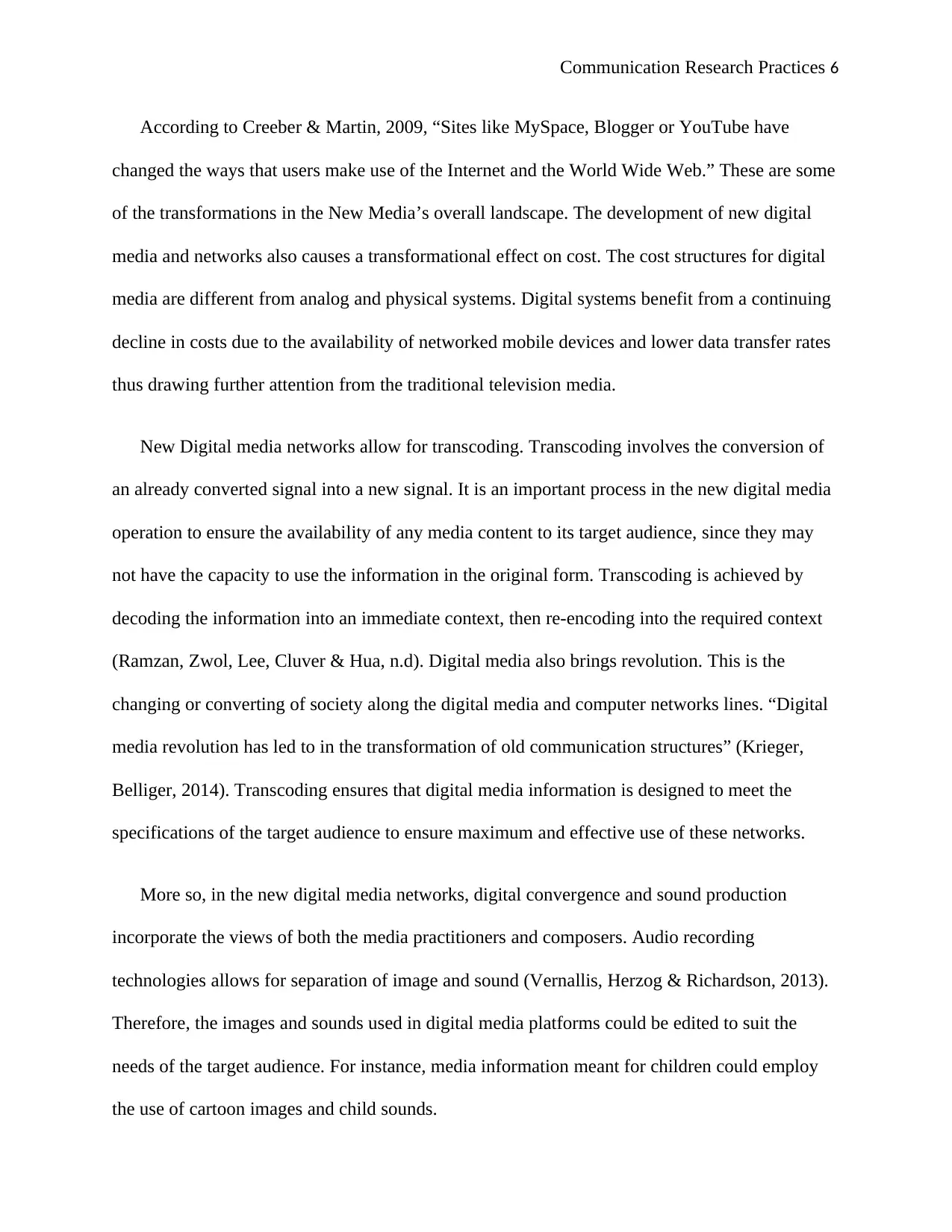
Communication Research Practices 6
According to Creeber & Martin, 2009, “Sites like MySpace, Blogger or YouTube have
changed the ways that users make use of the Internet and the World Wide Web.” These are some
of the transformations in the New Media’s overall landscape. The development of new digital
media and networks also causes a transformational effect on cost. The cost structures for digital
media are different from analog and physical systems. Digital systems benefit from a continuing
decline in costs due to the availability of networked mobile devices and lower data transfer rates
thus drawing further attention from the traditional television media.
New Digital media networks allow for transcoding. Transcoding involves the conversion of
an already converted signal into a new signal. It is an important process in the new digital media
operation to ensure the availability of any media content to its target audience, since they may
not have the capacity to use the information in the original form. Transcoding is achieved by
decoding the information into an immediate context, then re-encoding into the required context
(Ramzan, Zwol, Lee, Cluver & Hua, n.d). Digital media also brings revolution. This is the
changing or converting of society along the digital media and computer networks lines. “Digital
media revolution has led to in the transformation of old communication structures” (Krieger,
Belliger, 2014). Transcoding ensures that digital media information is designed to meet the
specifications of the target audience to ensure maximum and effective use of these networks.
More so, in the new digital media networks, digital convergence and sound production
incorporate the views of both the media practitioners and composers. Audio recording
technologies allows for separation of image and sound (Vernallis, Herzog & Richardson, 2013).
Therefore, the images and sounds used in digital media platforms could be edited to suit the
needs of the target audience. For instance, media information meant for children could employ
the use of cartoon images and child sounds.
According to Creeber & Martin, 2009, “Sites like MySpace, Blogger or YouTube have
changed the ways that users make use of the Internet and the World Wide Web.” These are some
of the transformations in the New Media’s overall landscape. The development of new digital
media and networks also causes a transformational effect on cost. The cost structures for digital
media are different from analog and physical systems. Digital systems benefit from a continuing
decline in costs due to the availability of networked mobile devices and lower data transfer rates
thus drawing further attention from the traditional television media.
New Digital media networks allow for transcoding. Transcoding involves the conversion of
an already converted signal into a new signal. It is an important process in the new digital media
operation to ensure the availability of any media content to its target audience, since they may
not have the capacity to use the information in the original form. Transcoding is achieved by
decoding the information into an immediate context, then re-encoding into the required context
(Ramzan, Zwol, Lee, Cluver & Hua, n.d). Digital media also brings revolution. This is the
changing or converting of society along the digital media and computer networks lines. “Digital
media revolution has led to in the transformation of old communication structures” (Krieger,
Belliger, 2014). Transcoding ensures that digital media information is designed to meet the
specifications of the target audience to ensure maximum and effective use of these networks.
More so, in the new digital media networks, digital convergence and sound production
incorporate the views of both the media practitioners and composers. Audio recording
technologies allows for separation of image and sound (Vernallis, Herzog & Richardson, 2013).
Therefore, the images and sounds used in digital media platforms could be edited to suit the
needs of the target audience. For instance, media information meant for children could employ
the use of cartoon images and child sounds.
⊘ This is a preview!⊘
Do you want full access?
Subscribe today to unlock all pages.

Trusted by 1+ million students worldwide
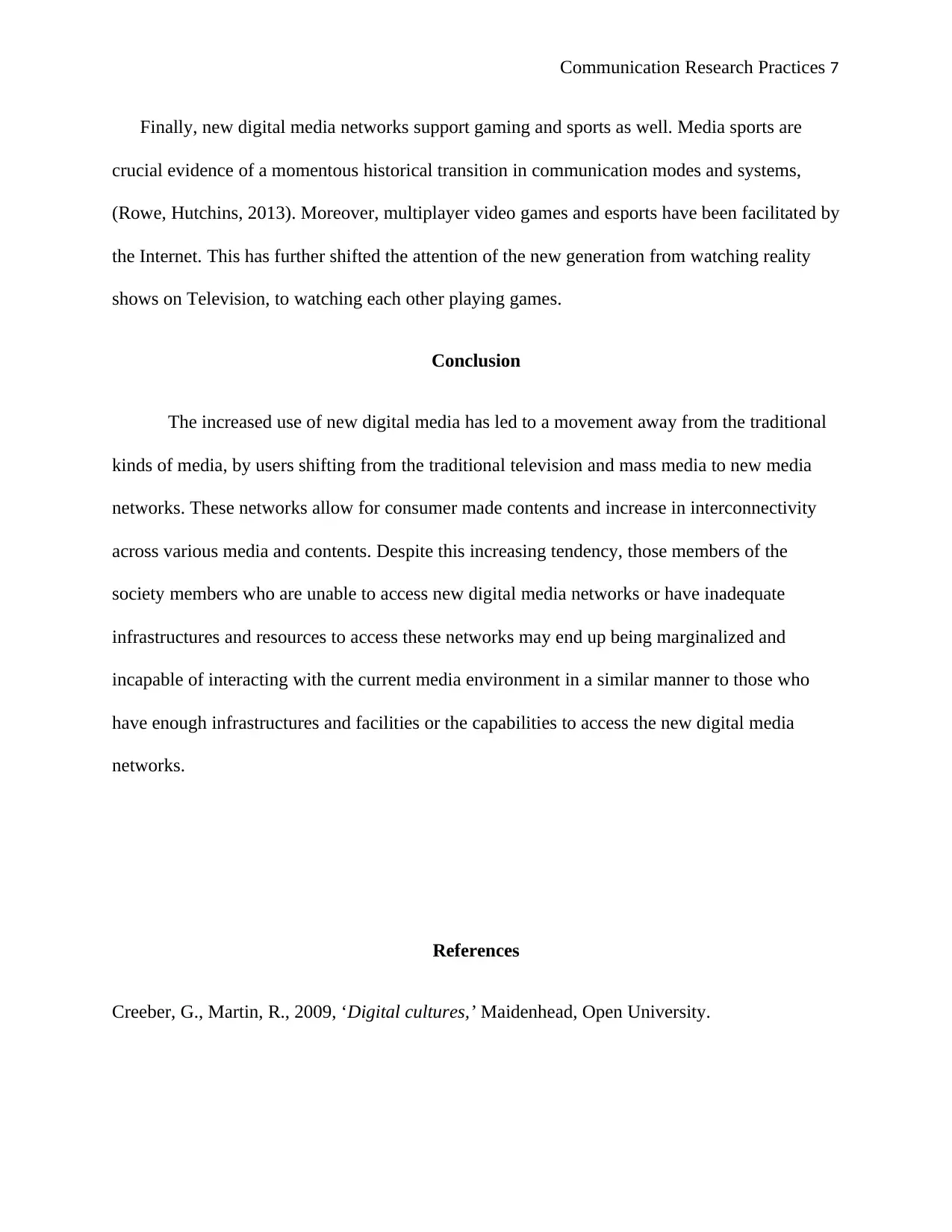
Communication Research Practices 7
Finally, new digital media networks support gaming and sports as well. Media sports are
crucial evidence of a momentous historical transition in communication modes and systems,
(Rowe, Hutchins, 2013). Moreover, multiplayer video games and esports have been facilitated by
the Internet. This has further shifted the attention of the new generation from watching reality
shows on Television, to watching each other playing games.
Conclusion
The increased use of new digital media has led to a movement away from the traditional
kinds of media, by users shifting from the traditional television and mass media to new media
networks. These networks allow for consumer made contents and increase in interconnectivity
across various media and contents. Despite this increasing tendency, those members of the
society members who are unable to access new digital media networks or have inadequate
infrastructures and resources to access these networks may end up being marginalized and
incapable of interacting with the current media environment in a similar manner to those who
have enough infrastructures and facilities or the capabilities to access the new digital media
networks.
References
Creeber, G., Martin, R., 2009, ‘Digital cultures,’ Maidenhead, Open University.
Finally, new digital media networks support gaming and sports as well. Media sports are
crucial evidence of a momentous historical transition in communication modes and systems,
(Rowe, Hutchins, 2013). Moreover, multiplayer video games and esports have been facilitated by
the Internet. This has further shifted the attention of the new generation from watching reality
shows on Television, to watching each other playing games.
Conclusion
The increased use of new digital media has led to a movement away from the traditional
kinds of media, by users shifting from the traditional television and mass media to new media
networks. These networks allow for consumer made contents and increase in interconnectivity
across various media and contents. Despite this increasing tendency, those members of the
society members who are unable to access new digital media networks or have inadequate
infrastructures and resources to access these networks may end up being marginalized and
incapable of interacting with the current media environment in a similar manner to those who
have enough infrastructures and facilities or the capabilities to access the new digital media
networks.
References
Creeber, G., Martin, R., 2009, ‘Digital cultures,’ Maidenhead, Open University.
Paraphrase This Document
Need a fresh take? Get an instant paraphrase of this document with our AI Paraphraser
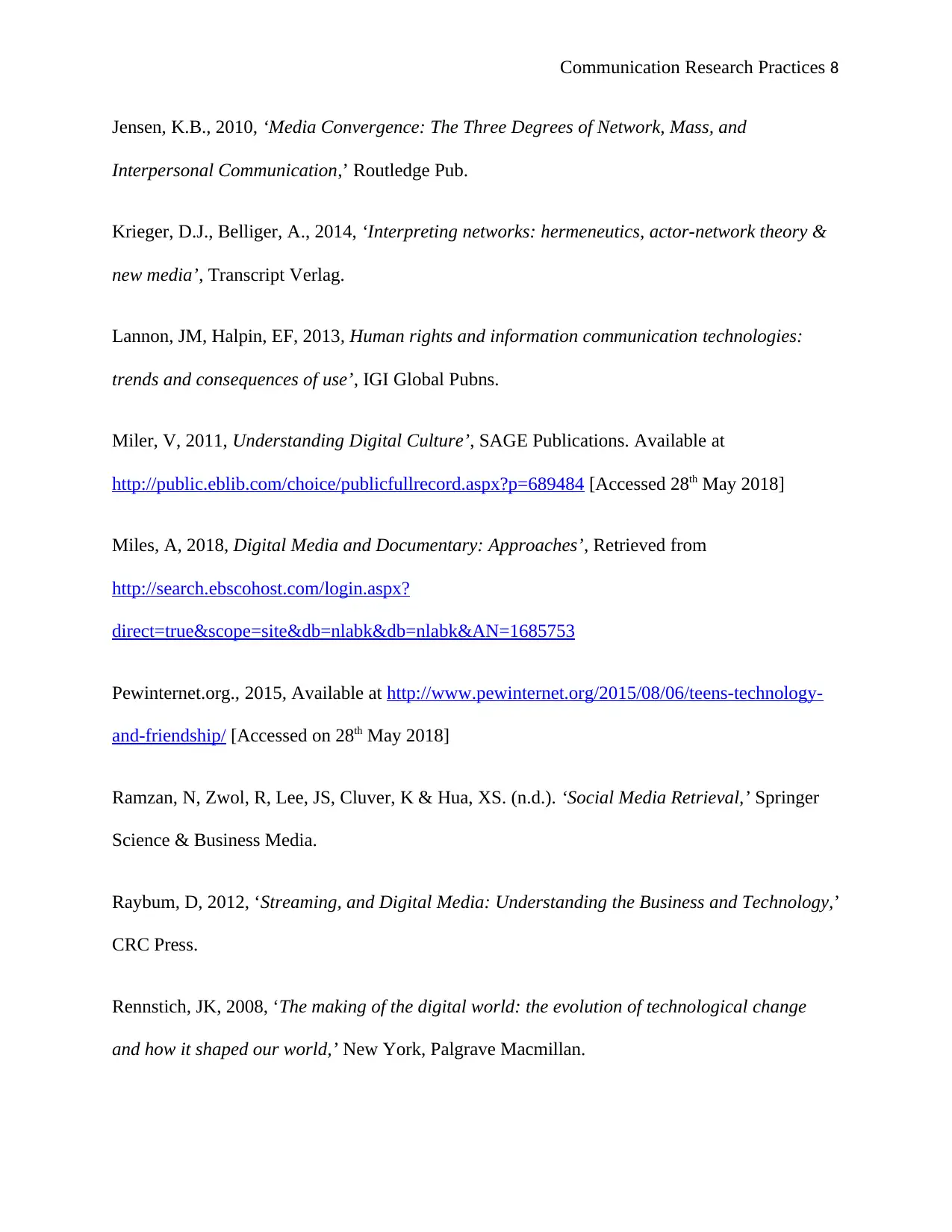
Communication Research Practices 8
Jensen, K.B., 2010, ‘Media Convergence: The Three Degrees of Network, Mass, and
Interpersonal Communication,’ Routledge Pub.
Krieger, D.J., Belliger, A., 2014, ‘Interpreting networks: hermeneutics, actor-network theory &
new media’, Transcript Verlag.
Lannon, JM, Halpin, EF, 2013, Human rights and information communication technologies:
trends and consequences of use’, IGI Global Pubns.
Miler, V, 2011, Understanding Digital Culture’, SAGE Publications. Available at
http://public.eblib.com/choice/publicfullrecord.aspx?p=689484 [Accessed 28th May 2018]
Miles, A, 2018, Digital Media and Documentary: Approaches’, Retrieved from
http://search.ebscohost.com/login.aspx?
direct=true&scope=site&db=nlabk&db=nlabk&AN=1685753
Pewinternet.org., 2015, Available at http://www.pewinternet.org/2015/08/06/teens-technology-
and-friendship/ [Accessed on 28th May 2018]
Ramzan, N, Zwol, R, Lee, JS, Cluver, K & Hua, XS. (n.d.). ‘Social Media Retrieval,’ Springer
Science & Business Media.
Raybum, D, 2012, ‘Streaming, and Digital Media: Understanding the Business and Technology,’
CRC Press.
Rennstich, JK, 2008, ‘The making of the digital world: the evolution of technological change
and how it shaped our world,’ New York, Palgrave Macmillan.
Jensen, K.B., 2010, ‘Media Convergence: The Three Degrees of Network, Mass, and
Interpersonal Communication,’ Routledge Pub.
Krieger, D.J., Belliger, A., 2014, ‘Interpreting networks: hermeneutics, actor-network theory &
new media’, Transcript Verlag.
Lannon, JM, Halpin, EF, 2013, Human rights and information communication technologies:
trends and consequences of use’, IGI Global Pubns.
Miler, V, 2011, Understanding Digital Culture’, SAGE Publications. Available at
http://public.eblib.com/choice/publicfullrecord.aspx?p=689484 [Accessed 28th May 2018]
Miles, A, 2018, Digital Media and Documentary: Approaches’, Retrieved from
http://search.ebscohost.com/login.aspx?
direct=true&scope=site&db=nlabk&db=nlabk&AN=1685753
Pewinternet.org., 2015, Available at http://www.pewinternet.org/2015/08/06/teens-technology-
and-friendship/ [Accessed on 28th May 2018]
Ramzan, N, Zwol, R, Lee, JS, Cluver, K & Hua, XS. (n.d.). ‘Social Media Retrieval,’ Springer
Science & Business Media.
Raybum, D, 2012, ‘Streaming, and Digital Media: Understanding the Business and Technology,’
CRC Press.
Rennstich, JK, 2008, ‘The making of the digital world: the evolution of technological change
and how it shaped our world,’ New York, Palgrave Macmillan.
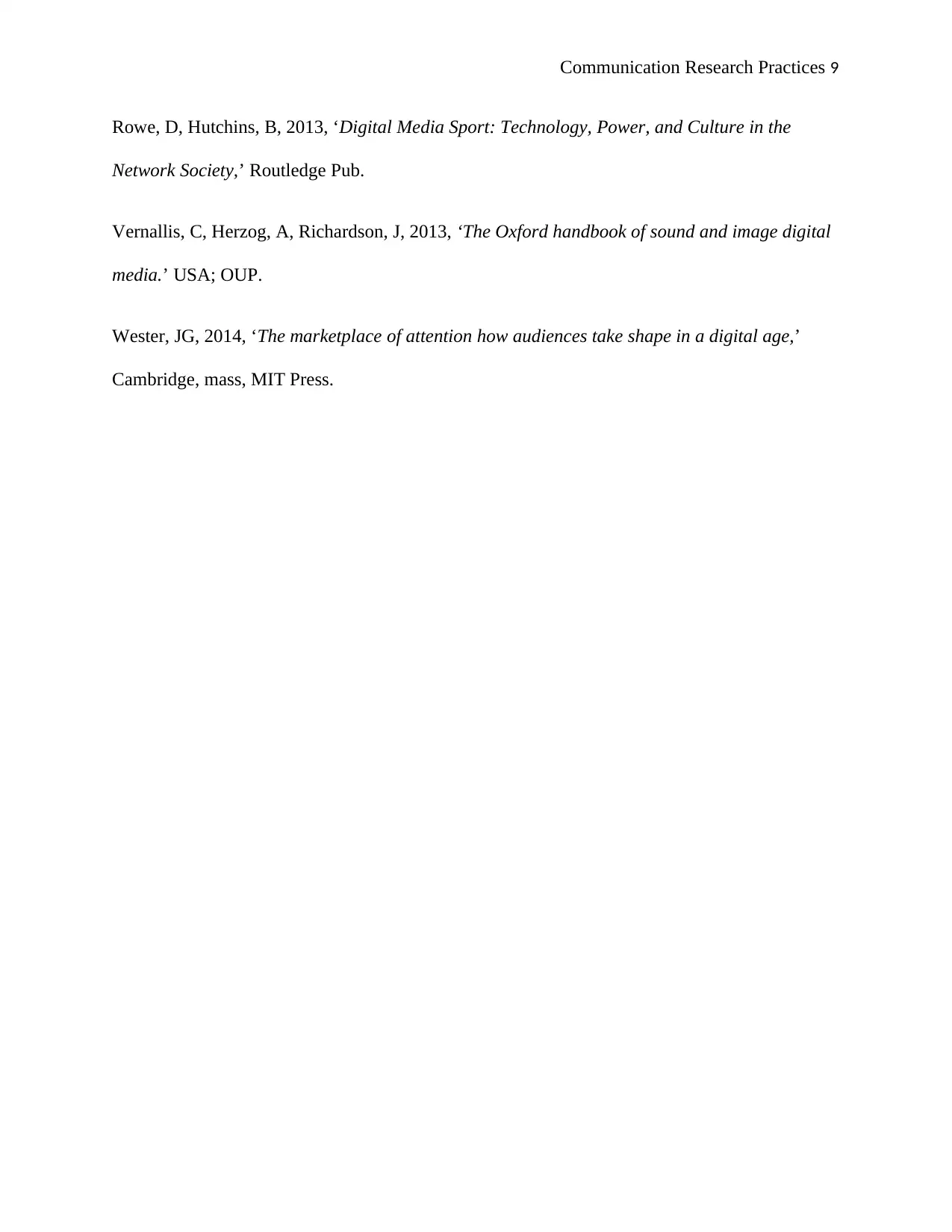
Communication Research Practices 9
Rowe, D, Hutchins, B, 2013, ‘Digital Media Sport: Technology, Power, and Culture in the
Network Society,’ Routledge Pub.
Vernallis, C, Herzog, A, Richardson, J, 2013, ‘The Oxford handbook of sound and image digital
media.’ USA; OUP.
Wester, JG, 2014, ‘The marketplace of attention how audiences take shape in a digital age,’
Cambridge, mass, MIT Press.
Rowe, D, Hutchins, B, 2013, ‘Digital Media Sport: Technology, Power, and Culture in the
Network Society,’ Routledge Pub.
Vernallis, C, Herzog, A, Richardson, J, 2013, ‘The Oxford handbook of sound and image digital
media.’ USA; OUP.
Wester, JG, 2014, ‘The marketplace of attention how audiences take shape in a digital age,’
Cambridge, mass, MIT Press.
⊘ This is a preview!⊘
Do you want full access?
Subscribe today to unlock all pages.

Trusted by 1+ million students worldwide
1 out of 9
Related Documents
Your All-in-One AI-Powered Toolkit for Academic Success.
+13062052269
info@desklib.com
Available 24*7 on WhatsApp / Email
![[object Object]](/_next/static/media/star-bottom.7253800d.svg)
Unlock your academic potential
Copyright © 2020–2025 A2Z Services. All Rights Reserved. Developed and managed by ZUCOL.





